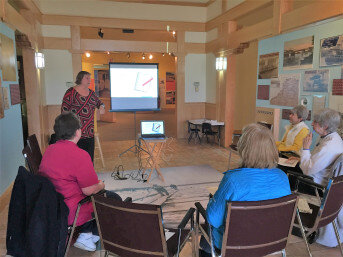Everyone has a story – or two – or more. Some are amazing, or outrageous, or heart-warming, or funny, or depressing, or frustrating, or… The thing is, these personal stories are what we usually take with us to the grave. They are also the “special something” that makes history come alive.
Our mission is to search, save, and share the history and cultural heritage of Scott County, which includes our stories. In our collection we have stories on paper – journals, letters, postcards, books, etc. We also have stories on cassette tape, video cassette, and digital files. However, not everyone kept a journal, or it’s still packed away in someone’s attic. Stories on cassette tapes, videos or digital files really aren’t very useful if you don’t know what’s on them – what topics were covered. It’s the transcripts that make the stories easy to search and use.
The SCHS conducted a six-year project to collect stories from the “Greatest Generation” a few years ago. With the help of dedicated volunteers, stories were collected on cassette tape from over 130 people in our county – over 70 with WWII Veterans. With the help of the women at the Shakopee Women’s Correctional Facility, all the tapes were transcribed, an intern converted the tapes to digital files, and we used snippets for an award-winning exhibit on WWII.
Because we were able to access the transcripts, we could choose snippets of stories to use in exhibits. Because they were digitally accessible, it was fairly easy to locate and pull out the snippet we chose, and convert it to the proper format for use.
Hearing someone’s voice describe something you are looking at, or a scene in the past, it creates images in your mind and through their voice, you are able to experience the past in a deeper and richer way.
I don’t know about you, but there are many times I’ve thought – Dang, wish I had thought to record my Mom’s stories about when she was little. Or… it would be great to hear Grandpa talk about how he made special lures for fishing. You know…, family lore and stories. These stories provide an anchor to our past, share special skills, link us to communities, and more. Unfortunately, we usually think of recording stories after the person has passed away.
At SCHS we thought of this too. To help capture and save those stories, we partnered with the Scott County Agricultural Society (SCAS), to create a mobile recording studio, named the “speak easy“.
The speak easy, is ADA compliant (it kneels to the ground, has a ramp, and space inside for wheelchairs); is comfortable (designed to look like a comfy kitchen); includes easy to use, professional recording equipment; and is available for anyone to use.
If you aren’t interested in the trailer, the recording equipment can also be rented separately.
With the holidays quickly approaching, it’s a wonderful time to think about actually capturing those family stories before they slip away.
We are here to help with advice on what questions to ask, how to ask them, how to capture the stories, and what to do with them once they are recorded.
The speak easy is available for rent – contact us for information at info@scottcountyhistory.org or give us a call at 952-445-0378.





